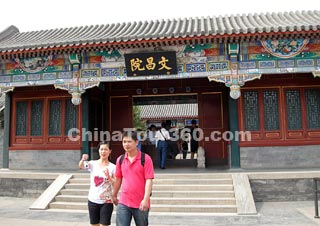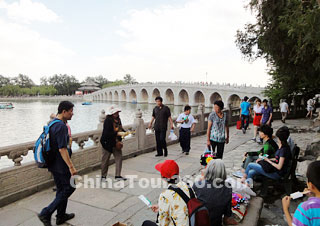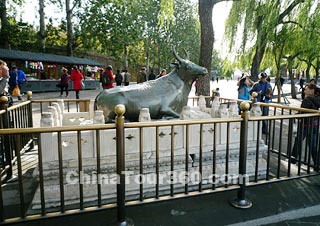Kunming Lake and Longevity Hill, two scenic spots that are among the many to see at Beijing's famous Summer Palace, were built complement each other. Kunming Lake was once called Wengshan Lake, as the Longevity Hill was named Weng Hill (Wengshan). Being located in the west suburb of Beijing, it is also named West Lake.
In the Qing Dynasty (1644 - 1911), Emperor Qianlong decided to build the Garden of Clear Ripples (Qingyiyuan) along Weng Hill. The lake was expanded to its current scale, and named Kunming Lake from a story that told Emperor Wudi of the Han Dynasty (260 BC - 220AD) had dug an artificial Kunming Lake for battle practice on waters in the ancient capital of Chang’an (present day Xian).
The environs of Kunming Lake Area mainly consists of three scenic areas: East Causeway, West Causeway and Three Islands. Each of the three areas has its own unique features. The East Causeway, with its wide vista, is a fantastic site to enjoy the overall scenery of the Summer Palace. The main scenic spots in this area are Heralding Spring Pavilion (Zhichun Ting), Wenchang Tower (Wenchang Ge), South Lake Island (Nanhu Dao), Seventeen-Arch Bridge (Shiqikong Qiao) and Bronze Ox (Tongniu). The West Causeway borrows the style of the Su Causeway in Hangzhou, with six bridges distributed on its north and south. Between the Silk Bridge (Lian Qiao) and the Willow Bridge (Liu Qiao) is the Pavilion of Bright Scenery (Jingming Lou) based upon the style of the Yueyang Tower in Hunan. You can either appreciate the pavilion at a distance or enjoy the view from within it.
![]() East Causeway
East Causeway
Located in the east of Kunming Lake, the East Causeway starts from Wenchang Tower (Wenchang Ge) in the north, and ends at the Xiuyi Bridge in the south. It’s an artificial causeway built during the period of Emperor Qianlong. It was explored upon the West Causeway of Garden of Eternal Spring(Changchunyuan). Later, it became the East Causeway of the Kunming Lake after the Kunming Lake was expanded by Emperor Qianlong. A huge Kunlun Rock carved with the West Causeway Poem by Emperor Qianlong sits on the East Causeway, providing proof that it was once West Causeway.
![]() Heralding Spring Pavilion (Zhichun Ting)
Heralding Spring Pavilion (Zhichun Ting)
Heralding Spring Pavilion is at the east bank of Kunming Lake and on a small island in front of the Hall of Jade Ripples (Yulan Tang). Visitors can lean on the railing to overlook the overall scenery, which makes it one of the best viewing sites in the Summer Palace. Standing in the pavilion, looking toward the distance, one has a stunning views of vast Kunming Lake, magnificent Longevity Hill, the tall and graceful Jade Spring Hill Pagoda as well as peaks in Western Hills which all come into view, layered from close by into the distance. The breath-taking landscape will make you relaxed and joyful.
 |
| Wechang Gallery |
![]() Wenchang Tower (Wenchang Ge)
Wenchang Tower (Wenchang Ge)
Wenchang Tower is the largest among the six towers in the Summer Palace, and the other five are Purple Cloud Tower (Ziqi Donglai Chengguan), Tower of Cloud-Retaining Eaves (Suyunyan Chengguan), Tower of Dawn Light (Yanhui Chengguan), Cloud-Reaching Tower (Tongyun Chengguan) and Tower of Thousand Peaks and Diverse Colors (Qianyun Caicui Chengguan). There is an excellent exhibition gallery in traditional courtyard style called Wechang Gallery here, which is the largest and best cultural relic exhibition hall. It holds the most exhibits among the classic Chinese gardens. Built in 1998 and finished in 2000, Wenchang Gallery is divided into six exhibition areas. Here thousands of pieces of priceless relics ranging from the Shang and Zhou dynasties till the late Qing Dynasty are presented, including bronze wares, jade articles, porcelain vessels, paintings and calligraphy as well as clocks and watches. Most of them are the most prized treasures in the Summer Palace.
![]() Memorial Temple of Yelv Chuchai (Yelv Chucai Ci)
Memorial Temple of Yelv Chuchai (Yelv Chucai Ci)
Situated on the east bank of Kunming Lake, to the south of the Hall of Benevolence and Longevity (Renshou Dian) and to the north of the Wenchang Tower, sits the Memorial Temple of Yelv Chuchai (Yelv Chucai Ci). There are three remaining halls and the grave that are regarded as the oldest examples of ancient architecture in the Summer Palace. The temple, built in the Yuan Dynasty (1271 - 1368), is one of the most famous historical sites in the west suburb of Beijing. In the Yuan and Ming dynasties, lost of visitors and celebrities came to see it and left a number of poems and inscriptions. In the Period of Emperor Guangxu, the temple was refurbished to its current scale.
 |
| Seventeen-Arch Bridge |
![]() Seventeen-Arch Bridge (Shiqikong Qiao)
Seventeen-Arch Bridge (Shiqikong Qiao)
The Seventeen-Arch Bridge stretches between the South Lake Island and the East Causeway is the longest bridge among the Chinese imperial gardens. Built in 1750, the bridge is 150 meters (164 yards) long and 8 meters (8.7 yards) wide. The railings of the bridge were carved with 544 stone lions as the Lugou Bridge. However, the craftsmanship and the numbers of lions both exceed those of the Lugou Bridge.
![]() Spacious Pavilion (Kuoru Ting)
Spacious Pavilion (Kuoru Ting)
There is also an example of pavilion-style architecture in the Summer Palace that is the largest of its kind in China. It's the Spacious Pavilion (Kuoru Ting) covering an area of 130 square meters (155 square yards). The pavilion stands on the east side of Seventeen-Arch Bridge and is double-layered pavilion with eight eave angles, so also called Eight-Direction Pavilion. It’s said that, seen from afar, the Spacious Pavilion, the Seventeen-Arch Pavilion and the South Lake Island link together and form the shape of a tortoise, which represents the Longevity of the emperor.
 |
| Bronze Ox |
![]() Bronze Ox (Tongniu)
Bronze Ox (Tongniu)
On the East Causeway of the Kunming Lake and close to the Seventeen-Arch Bridge, there is an almost life-sized bronze ox laying beside the water. It was sculptured in 1775 and given the name 'Golden Ox' as it was made of bronze and plated with gold. Bronze was often referred to as gold in ancient China. It was built in the hope of bring in happiness and welfare for the people inside and around the Summer Palace. Moreover, the base of the bronze ox is 10 meters higher than that of the Forbidden City, so it also functioned as a monitor for the water lever of the moats of the Forbidden City.
![]() West Causeway
West Causeway
Built in the same style as the East Causeway of the West Lake in Hangzhou, the West Causeway is covered by willows. It also has six bridges: Lake-Dividing Bridge (Jiehu Qiao), Bridge of Pastoral Poems (Binfeng Qiao), Jade Belt Bridge (Yudai Qiao), Mirror Bridge (Jing Qiao), Silk Bridge (Lian Qiao) and Willow Bridge (Liu Qiao). Among them, the Jade Belt Bridge, built in the years under Emperor Qianlong’s reign, is the most prestigious. It is curved like a jade belt, hence its name.
![]() Three Islands Area
Three Islands Area
Situated in the original site of the Kunming Lake, the South Lake Island is a paradise in the Summer Palace. It is the largest island in the lake, covering an area of over ten thousand square meters (2.5 acres). It was so named because people customarily divide the Kunming Lake into East Lake and South Lake, and this island is just in the south lake. The South Lake Island, together with the Seaweed-Viewing Island (Zaojian Tang) and the Circle City Island (Yejing Ge), represent the three legendary immortal islands in the China East Sea - 'Penglai', 'Fangzhang' and 'Yingzhou', where the eight immortals were said to live.
There are two buildings on the South Lake Island which are worth mentioning. One is the Temple of Timely Rains and Extensive Moisture (Guangrun Lingyu Ci). Originally built in the Ming dynasty, it is one of the oldest buildings in the Summer Palace. The other is the Hall of Embracing the Universe (Hanxu Tang). It is on the northernmost part of the South Lake Island and faces the Longevity Hill across the Kunming Lake. It was originally built in the style of 'Moon-Admiring Pavilion' by imitating the designs Garden of the Yellow Crane Tower in Wuhan. Later, it was lowered from three layers to only one because of the subsidence of the basement.
The sightseeing areas of Kunming Lake Area takes up three quarters of the entire Summer Palace lands. As the area is so large, visitor may want to plan in advance which scenic spots they will visit so as to avoid being too exhausted to see other attractions in Beijing later. Additionally, please note that there is no washrooms in the areas from the Spacious Pavilion to the Xiuyi Bridge, nor in the entire West Causeway Area.
![]() Go to the Next Scenic Area: Longevity Hill - Front Hill Area
Go to the Next Scenic Area: Longevity Hill - Front Hill Area








